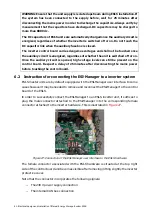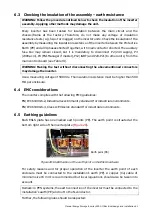
Manual Energy Storage Inverter ESI-S
Electrical design and installation 43
The multiplication factor X is a factor that takes into account that the current that will
flow through the inverter connection cables is predominantly a harmonic current, i.e. a
current of which the frequency of the most important components is higher than the
network base frequency. Due to the frequency being higher than the network base
frequency a physical phenomenon called ‘skin effect’ comes into play. This effect implies
that for higher frequencies the current will not flow through the complete cross section
of the cable but will have the tendency to flow at the cable surface. The result is that
although one may use a cable of A mm², the section through which the current flows is
only X*A m² (with X < 1). In order to compensate for this “loss of section”, the cable has
to be oversized such that the total equivalent section through which the current flows
taking into account the skin effect is acceptable.
The multiplication factor X to be used depends on the cable material (e.g. copper [Cu],
aluminum [Al]) and on the base frequency of the network on which the inverter will be
installed. For a given installation its value can be determined using the following process:
Step 1: Determine in a conventional way (e.g. using cable manufacturer’s tables) the
cable section A (mm²) for the RMS current Irms obtained in 1 above.
Step 2: Using the cable section A, the cable material and the network frequency as entry
points in
, determine the multiplication factor X. For the DC current, the
multiplication factor X is equal to 1.
Table 19: Multiplication factors X for different cable sections
Cable section [mm²]
Network frequency 50Hz Network frequency 60 Hz
Al-cable Cu-cable Al-cable
Cu-cable
16
1.00
1.00
1.00
1.00
25
1.00
1.01
1.00
1.01
35
1.01
1.01
1.01
1.02
50
1.01
1.03
1.02
1.04
70
1.02
1.05
1.03
1.06
95
1.04
1.08
1.05
1.10
120
1.05
1.11
1.07
1.14
Step 3: Determine in a conventional way the cable section A2 (mm²) for the current rating
found by multiplying Irms by X.
If the new cable section A2 is equal to the initially found cable section A, the right cable
section taking into account the skin effect has been found.
If the new cable section A2 is bigger than the initially found cable section A, steps
2 and 3 have to be repeated with the new values until the cable section A2 found is equal
to the cable section A.
Remark: during this process it may be found that more than one cable per phase is
needed. The process then has to be applied to each cable.
















































